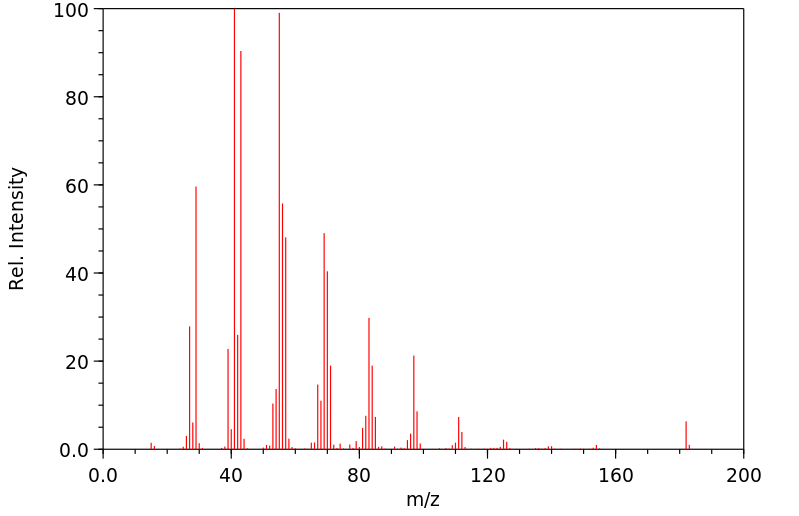(Z)-2-十三(碳)烯 | 41446-59-7
中文名称
(Z)-2-十三(碳)烯
中文别名
——
英文名称
(Z)-2-tridecene
英文别名
(Z)-tridec-2-ene;cis-2-Tridecene
CAS
41446-59-7
化学式
C13H26
mdl
——
分子量
182.349
InChiKey
XWVHBWQEYOROBE-HYXAFXHYSA-N
BEILSTEIN
——
EINECS
——
-
物化性质
-
计算性质
-
ADMET
-
安全信息
-
SDS
-
制备方法与用途
-
上下游信息
-
文献信息
-
表征谱图
-
同类化合物
-
相关功能分类
-
相关结构分类
物化性质
-
保留指数:1311;1313;1302
-
稳定性/保质期:
存在于烟气中。
计算性质
-
辛醇/水分配系数(LogP):7
-
重原子数:13
-
可旋转键数:9
-
环数:0.0
-
sp3杂化的碳原子比例:0.85
-
拓扑面积:0
-
氢给体数:0
-
氢受体数:0
SDS
反应信息
-
作为反应物:描述:(Z)-2-十三(碳)烯 在 acetylacetonatodicarbonylrhodium(l) 、 1-hydroxytetraphenylcyclopentadienyl(tetraphenyl-2,4-cyclopentadien-1-one)-μ-hydrotetracarbonyldiruthenium(II) 、 一氧化碳 、 C70H72O2P2 、 氢气 作用下, 以 1,4-二氧六环 为溶剂, 120.0 ℃ 、500.01 kPa 条件下, 反应 36.0h, 以83%的产率得到十三烷醇参考文献:名称:使用 Rh/Ru 双或三元催化剂系统串联异构化/加氢甲酰化/氢化内烯烃吨醇摘要:内烯烃异构化/加氢甲酰化/加氢生成正醇的一锅三步反应是通过使用Rh/Ru双催化剂体系完成的。通过使用 Rh(acac)(CO)2/二亚磷酸酯和 Shvo 催化剂的组合,(Z)-2-十三烯以 83% 的产率转化为 1-十四醇,具有高正/异选择性 (n/i = 12)。该方法适用于其他内部烯烃,包括功能化烯烃,如烯醇和烯酸酯。此外,第三种组分 Ru3(CO)12 的加入有效地提高了油酸甲酯串联异构化/加氢甲酰化/氢化中的 n/i 比(从 n/i = 1.9 到 4.4)。对照实验表明异构化是由 Rh 和 Ru 介导的,并且 Rh 和 Ru 的共存对于 H2/CO 下醛的加氢是必不可少的。DOI:10.1021/ja407523j
-
作为产物:描述:参考文献:名称:Cleavage of silicon-vinyl carbon bond by nBu4NF摘要:DOI:10.1016/s0040-4039(00)88048-x
文献信息
-
Dilithium Amides as a Modular Bis-Anionic Ligand Platform for Iron-Catalyzed Cross-Coupling作者:Peter G. N. Neate、Bufan Zhang、Jessica Conforti、William W. Brennessel、Michael L. NeidigDOI:10.1021/acs.orglett.1c02053日期:2021.8.6Dilithium amides have been developed as a bespoke and general ligand for iron-catalyzed Kumada–Tamao–Corriu cross-coupling reactions, their design taking inspiration from previous mechanistic and structural studies. They allow for the cross-coupling of alkyl Grignard reagents with sp2-hybridized electrophiles as well as aryl Grignard reagents with sp3-hybridized electrophiles. This represents a rare
-
Stereoselective Wittig olefination reactions employing a novel ortho-P-aryl alkoxide effect作者:James McNulty、Kunal KeskarDOI:10.1016/j.tetlet.2008.09.150日期:2008.12Non-stabilized ortho-P-alkoxy-substituted ylides react with aromatic and aliphatic aldehydes providing (E)-olefins with high stereocontrol, also allowing easy phosphine oxide removal in certain cases.非稳定的邻-P-烷氧基取代的基团与芳族和脂族醛反应,可提供高度立体控制的(E)-烯烃,在某些情况下还易于去除氧化膦。
-
Gram-Scale, Cheap, and Eco-Friendly Iron-Catalyzed Cross-Coupling between Alkyl Grignard Reagents and Alkenyl or Aryl Halides作者:Gérard Cahiez、Guillaume Lefèvre、Alban Moyeux、Olivier Guerret、Eric Gayon、Loïc Guillonneau、Nicolas Lefèvre、Qinzhuo Gu、Edouard ZhouDOI:10.1021/acs.orglett.9b00665日期:2019.4.19A new robust methodology for gram-scale iron-catalyzed cross-coupling between alkyl Grignard reagents and alkenyl or aryl halides is developed. This method does not require toxic additives such as NMP or expensive ligands. Its efficiency relies on the use of simple alkoxide magnesium salts as additives. On the basis of these results, a new procedure for one-pot synthesis of substituted benzamides from
-
The Reactivity of Epoxides with Lithium 2,2,6,6-Tetramethylpiperidide in Combination with Organolithiums or Grignard Reagents作者:David M. Hodgson、Matthew J. Fleming、Steven J. StanwayDOI:10.1021/jo070291v日期:2007.6.12-disubstituted epoxides in the presence of LTMP to generate alkenes in a completely regio- and highly stereoselective manner. Arylated alkenes, dienes, allylsilanes, and enynes are accessed using this procedure. The methodology is applied in the synthesis of the roller leaf moth pheromone, (3E,5Z)-dodecadienyl acetate. The corresponding reaction without LTMP has also been examined, and a study using deuterated
-
Alkylidenation of Carbonyl Compounds with <i>gem</i>-Dizincioalkanes Mediated with Titanium Dichloride作者:Seijiro Matsubara、Tsuyoshi Mizuno、Tasuyuiki Otake、Masami Kobata、Kiitiro Utimoto、Kazuhiko TakaiDOI:10.1055/s-1998-1980日期:1998.12Olefination of carbonyl compounds with gem-dizincioalkanes, bis(iodozincio)methane, 1,1-bis(iodozincio)ethane, and bis(bromozincio)methyltrimethylsilane, afforded the corresponding olefins in good to excellent yields.
表征谱图
-
氢谱1HNMR
-
质谱MS
-
碳谱13CNMR
-
红外IR
-
拉曼Raman
-
峰位数据
-
峰位匹配
-
表征信息
同类化合物
高密聚乙烯
香叶醇
顺式3-甲基-2-己烯
顺式-5-癸烯
顺式-5-甲基-2-己烯
顺式-5-庚烯-1-炔
顺式-4-癸烷
顺式-4-甲基-2-戊烯
顺式-4-甲基-2-戊烯
顺式-3-癸烯
顺式-3-甲基-3-己烯
顺式-3-甲基-2-庚烯
顺式-3-戊烯-1-炔
顺式-3,4-二甲基-3-己烯
顺式-3,4-二甲基-2-戊烯
顺式-3,4-二甲基-2-戊烯
顺式-2-甲基-3-己烯
顺式-2-壬烯
顺式-2-丁烯-D1
顺式-1.1.1-三甲基-2-丁烯
顺式-1-甲基-2-环丙基乙烯
顺式-1-甲基-2-乙烯基环戊烷
顺式-1-环戊基-1-辛烯
顺式-1-氘代-3-甲基-1-丁烯
顺式-(9ci)-2,3,3a,7a-四氢-4-(1-甲基乙基)-1H-茚
顺式-(2-丁烯基)环丙烷
顺式,顺式-2,4-己二烯
顺-环辛烯
顺-9-二十一碳烯
顺-6-十三碳烯
顺-5-甲基-1,3,6-庚三烯
顺-4-辛烯
顺-4-壬烯
顺-3-辛烯
顺-3-甲基-2-戊烯
顺-3-壬烯
顺-3-十三碳烯
顺-2-辛烯
顺-2-癸烯
顺-2-戊烯
顺-2-庚烯
顺-2-己烯
顺-2-丁烯
顺-2,2-二甲基-3-己烯
顺-1,3-戊二烯
顺,顺-1,9-环十六烷二烯
顺,顺,顺-环癸-1,3,5-三烯
间戊二烯
间二(4-吡啶基)苯
镁,二-2-丁烯基-







